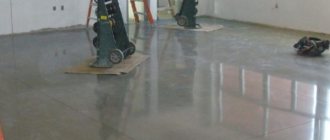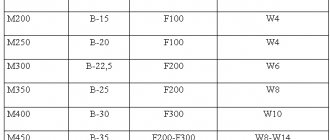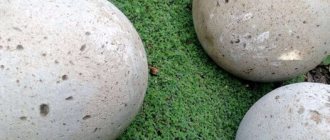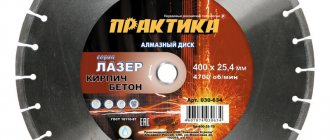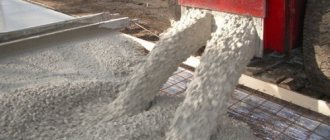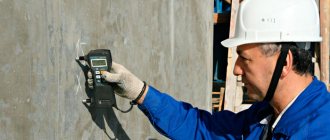The technology for constructing buildings of simple and complex construction involves the creation of foundation protection that prevents the negative effects of moisture. The presence of such protection can significantly extend the life of the house itself.
One of the methods for creating protection for the base of a structure is coating waterproofing, the best material for which is waterproofing mastic made on the basis of polymer compounds.
Benefits of mastic
Coating waterproofing is one of the most popular methods of waterproofing the foundations of buildings and structures.
The advantages of using this method are as follows:
- When creating this protection, no seams are formed that in the future could expose the foundation and thus give access to moisture;
- Easy to apply. You can apply mastic using hand tools, for example, a spatula, or spray it using special equipment. In this case, the application of mastic is called sprayed waterproofing. Spraying allows you to apply mastic to the most inaccessible places, as well as create a layer of waterproofing of the same density;
- The cost of such waterproofing due to the relatively low labor intensity and low price of consumables is quite acceptable.
However, it is worth noting that coating waterproofing the base of a building or structure will help protect the base from moisture only if construction is carried out in low-moisture soils, when the water in the soil is at a depth of one and a half meters below the basement level. In other words, a layer of mastic can only protect against capillary moisture.
Types and method of waterproofing
Based on the focus of protection, two main types of waterproofing can be distinguished:
- horizontal;
- vertical.
Vertical waterproofing is the provision of protection from moisture to walls and other vertical structures of a building and structure. But horizontal insulation is the insulation of the base of the house.
Horizontal waterproofing must be planned even during the marking of the foundation, since this layer will protect the base from the harmful effects of water in the ground and will serve as a kind of drainage system. Creating additional protection against moisture takes a lot of time, approximately twelve to fifteen days are needed.
Horizontal waterproofing is the only way to protect the base of a building and structure from groundwater. Especially if construction is carried out in an area with a high groundwater level.
In the presence of insulation, a protective cushion is formed between the foundation and the soil layer saturated with water.
If the ground level in the area where construction is taking place is high, then in addition to waterproofing the foundation, it is necessary to take care of the drainage system. Drainage must be created before the foundation is built.
Waterproofing materials
The use of special materials made on the basis of bitumen makes it possible to isolate not only the foundation, but also other structures of the building or structure from moisture. In addition to the oil refining product bitumen, special polymer additives are added to the mastic.
The main function of such components is to give the mastic durability, the layer of ductility and strength created with its help, etc. In addition, solvents can be added to the mixture to give it special properties.
Today there are several types of mastics on the building materials market:
- Hot mastic, the main difference of which is that it should be prepared immediately before use on the construction site. The main advantage of hot mastic is its relatively low cost.
Hot mastic creates a moisture-resistant layer that perfectly protects any structure from dampness and corrosion.This mixture contains a solvent that has high penetrating ability. This property of the bitumen mixture ensures high adhesion of the mastic and the surface that it should protect from exposure to water.
- Cold mastic. It is more expensive than hot mastic, but it is less hassle because it is sold ready-made. The company has already added all the solvents and additives necessary to give the mixture the required properties.
Cold mastic is not exposed to water vapor, so the protective layer it forms on the surface does not swell over time.Cold mastic can be applied using hand tools, a spatula, or a sprayer, although it is worth paying attention to the viscosity of the mixture when choosing an application method.
Waterproofing mastics and sealants
Trade and production carries out wholesale supplies of bitumen sealants and mastics for waterproofing and sealing work in any climatic conditions. What makes our products particularly valuable is their excellent performance characteristics: water resistance, excellent adhesion to various surfaces, including wet substrates, resistance to aggressive environments and severe loads. Many materials are optimal for use at high sub-zero temperatures.
Waterproofing mastics and sealants are viscous and liquid substances created on the basis of a bitumen composition and supplemented with polymers, solvents, corrosion inhibitors and other additives. These products are classified into one- and two-component. The first are materials that are ready for use and have a short shelf life. The latter consist of two components, are mixed before starting work and have a longer shelf life.
After application to the surface, bitumen mastics and sealants turn into monolithic and seamless coatings that provide waterproofing protection to structures and structures. Such materials from MasticIzol LLC are equally in demand for local and large-scale work on both residential and industrial sites. Different application technologies (manually or using equipment) allow them to be used in areas with the most complex configurations.
Thanks to their waterproofness, elasticity, strength and high adhesion to any surface, they create reliable and durable protection against precipitation, aggressive environments and mechanical deformation. Their fluidity and lack of shrinkage significantly save consumption, and their fast drying speed optimizes the overall progress of work. A wide range of operating temperatures allows the use of bitumen waterproofing mastics and sealants in any climatic regions of the Russian Federation.
Waterproofing mastics and sealants - the main advantages
- Resistance to precipitation and UV radiation;
- Optimal for surfaces in constant contact with water;
- Manual and mechanical installation;
- High hardening speed;
- Economical consumption;
- Low price.
Waterproofing mastics and sealants - areas of application
- Anti-corrosion protection of pipeline communications;
- Construction and reconstruction of roofs;
- Waterproofing of buildings, structures, engineering structures;
- Bonding of rolled and other building materials;
- Sealing of seams, joints, junctions, cracks and other deformation voids.
Choosing mastic for the type of room
The mastic, which is used to create waterproofing for the base of a house, can be classified taking into account a variety of properties of the mixture, for example, the type of solvents used in the production of mastic and the conditions under which this material can be used.
The following materials can be used to create coating waterproofing:
- Mineral, cement, masses mixed with polymers and granulates. This mixture dries best at high temperatures and low humidity, but if the mixture is used at low temperatures and high humidity, it may take a long time to dry. As a result of drying, a layer resistant to moisture and pressure is formed;
- Mineral epoxy masses that contain epoxy additives. Additives are necessary to give the mass density and elasticity. The insulation layer created using such mixtures is thinner than when using mineral masses;
- Bituminous masses, which have recently become very popular for creating insulation for the base of a house . The layer formed by the dried bitumen mass is strong and flexible, able to withstand high pressure and prolonged exposure to moisture, as well as excellent adhesion and adhesion to the surface material. The thickness obtained using a bitumen mixture is at least four millimeters.
Consumption of waterproofing bitumen mastic
When planning to waterproof with bitumen mastic, it is very important to determine its consumption. The easiest way to find out how much material is needed to complete this job is by reading the label . Although the exact rate of mastic consumption is not given there, from the information presented you can find out the recommended minimum for the layer being created. Based on this information, you can easily determine what the consumption of this material will be. Typically, a significant proportion of the mastic composition is made up of volatile solvents, which account for 30-70%. These numbers should be taken as the percentage of material shrinkage that will begin to occur after processing is completed.
When determining the average consumption of bitumen mastic per 1 square meter, you should focus on the type of structure that needs to be protected from moisture. So, for the foundation it will be 24 kg, for the roof 3.5 - 6 kg, for roofing felt 1 - 2 kg.
However, most often you can obtain information about the consumption of mastic from the information given on its label. If hot mastic was chosen for waterproofing, then you should be prepared for the fact that the consumption rate will be slightly higher than the average. In this case, you can be sure that the final value will not exceed the maximum values.
When waterproofing a concrete product, it is very important to create a coating of the required thickness. The easiest way to do this is to perform this operation by applying two or three layers.
Technological process of applying mastic
The base, which must be protected by coating waterproofing, must be strong and continuous. All corners of the foundation must be rounded, the radius of rounding varies from three to five centimeters, or have a chamfer.
At the point where horizontal surfaces transition into vertical ones there should be fillets, also known as fillets, which ensure a smooth transition.
First stage
The first stage of creating foundation waterproofing using mastic is preparatory.
The preparatory stage involves the following work:
- It is necessary to inspect the surface. If there are sharp corners, it is necessary to make roundings or chamfers, as well as fillets. Such elements will allow you to evenly apply a layer of mastic to the surface.
- In addition, you need to pay attention to the presence of shells, cracks and air bubbles. Such effects can be eliminated using cement mortar, which must dry before applying mastic.
If such defects are not eliminated, air bubbles may form on the surface of the layer of dried bitumen mixture.Scallops and sharp protrusions must also be removed before applying mastic to the surface of the foundation.
- The surface of the base of a building or structure should be cleaned of a variety of contaminants , including remnants of mortars and dust, and construction debris should also be removed;
- The base surface must be dry. Otherwise, moisture protection will simply lose its meaning. In addition, the presence of moisture on the surface of the foundation leads to swelling of the dried bitumen-polymer layer, as well as to its detachment. Surface humidity should not exceed four percent. Water-based mastic can be applied to a foundation surface with a moisture content of eight percent. However, there is no mastic that can be used on wet substrates. So the work of applying mastic can only be done at low humidity levels;
- In order to improve the adhesion of the applied material and the surface, a bitumen primer can be applied to it, which is essentially a primer for working with bitumen. Application can be carried out using a brush or roller, or using special equipment that sprays the primer evenly over the surface of the base.
It is worth noting that there are several types of primer for bitumen, so the choice of this composition must be selected taking into account the characteristics of the mastic used to create waterproofing.To increase adhesion, it is enough to apply one layer of primer, but if defects have been eliminated, then in the place where they were, it is necessary to apply two layers of primer. Before you start applying the mastic, you should wait until the primer previously applied to the surface dries.
Second phase
The second stage of creating coating waterproofing for the base of a building or structure is directly applying mastic to the surface:
- You can apply mastic using tools such as a roller, brush or spatula. It all depends on the viscosity of the mixture and the area that needs to be treated.
- The mixture can also be sprayed , so you can distribute the mastic evenly and much faster.
- If the mastic is applied in several layers , then the next layer should be applied only after the previous one has dried.
Application area
The scope of application of bitumen mastics is extremely wide:
- For waterproofing any underground structures and structures, bathrooms, pipelines, basements, wells, swimming pools;
- For roofing bitumen sealing. Without the use of technology, you can cover and reliably protect any roof;
- For reliable fastening of rolled materials;
- For processing wooden parts that are buried in the ground. This is a proven and reliable way to preserve wood from rotting, fungi, mold, etc.;
- For all types of foundations;
- For all types of concrete and reinforced concrete structures;
- Bitumen mastic is an excellent protection against corrosion of all types of metals;
- For asphalt repair. Operation of the roadway is permitted an hour after completion of work.
Depending on the base on which this or that mastic is applied, the appropriate primer is selected. For different materials, concrete, plaster, metal, wood, asphalt, a different primer is used. Often old concrete or cement surfaces have very low adhesion when performing repair work, so pre-treatment with a primer is mandatory. Refusal to use it for the purpose of saving can lead to a sharp loss of the operational qualities of the object, the restoration of which will require significant funds.
The use of a primer guarantees strength, wear resistance and overall reliability of working surface protection.
Bitumen primer is recommended for use when it is necessary to perform waterproofing when carrying out all types of roofing work, on foundations, on floors, on bridge spans, on underground structures and structures, on pipelines. Mastic applied to the primer will reliably protect any metal parts and structures from corrosion.
